Last updated on August 2nd, 2014
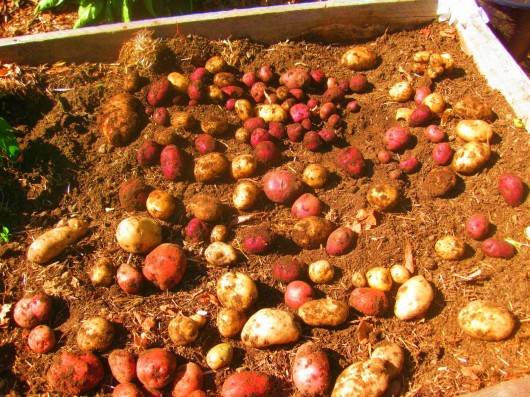 FOR THE PAST TEN SPRINGS, I’ve planted my seed-potatoes in deep holes, and then “hilled” the developing plants with soil. This method, which you can witness here, never failed to produce an enormous crop. But this year, purely for the sake of experiment, I tried a different, and infinitely-easier approach. Have a look:
FOR THE PAST TEN SPRINGS, I’ve planted my seed-potatoes in deep holes, and then “hilled” the developing plants with soil. This method, which you can witness here, never failed to produce an enormous crop. But this year, purely for the sake of experiment, I tried a different, and infinitely-easier approach. Have a look:
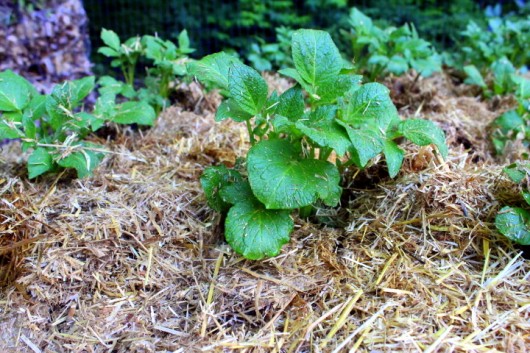 I simply placed the potatoes on a bed of soil, and then hilled them with chopped, weed-free straw.
I simply placed the potatoes on a bed of soil, and then hilled them with chopped, weed-free straw.
Of course, as the straw exceeded the height of the raised bed, I had to find a way to contain it. Otherwise, the material might topple over the edge of the bed.
I purchased 4 pieces of the cheapest pine my lumber store had to offer. The lumber yard cut the boards just slightly smaller than my existing hemlock-framed bed. This raised the planting quarters by 12 inches.
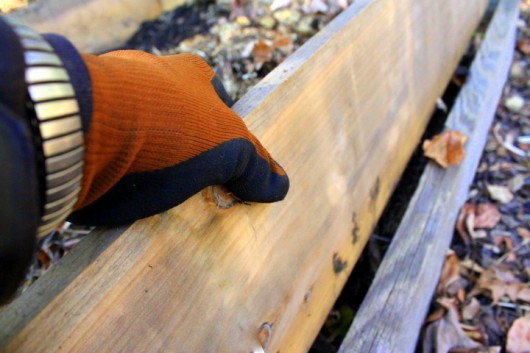 Because the pine frame is light-weight, I can easily lift it, and transport it to the garden shed for winter-storage. And because I rotate my crops each year, the frame can be used at different beds in the Kitchen Garden over subsequent years.
Because the pine frame is light-weight, I can easily lift it, and transport it to the garden shed for winter-storage. And because I rotate my crops each year, the frame can be used at different beds in the Kitchen Garden over subsequent years.
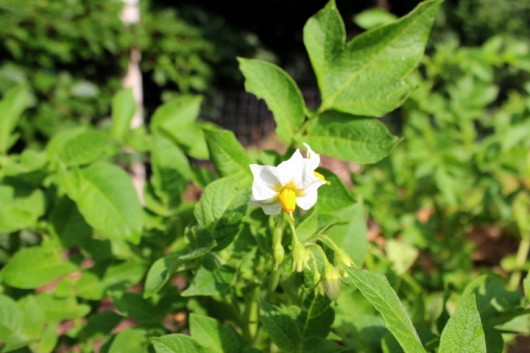 Did you know that soil — when it is covered with a 12-inch layer of straw — will remain moist and cool for a stunningly-long time? Honestly, I watered my potato bed only twice during the entire growing season.
Did you know that soil — when it is covered with a 12-inch layer of straw — will remain moist and cool for a stunningly-long time? Honestly, I watered my potato bed only twice during the entire growing season.
But what kind of harvest would this method produce? The results were revealed this morning, when I removed straw from one small portion of the bed.
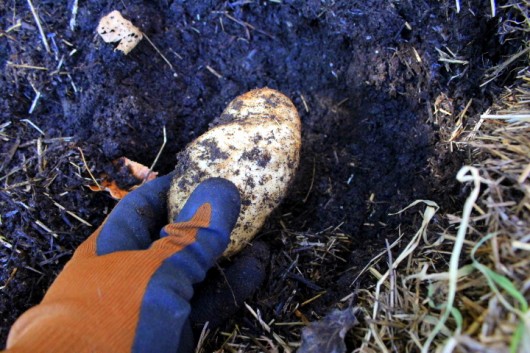 I found potatoes! True, the spuds were slightly smaller than their soil-grown kin. But they were oh-so-easy to harvest. With my previous method, I had to use a pitchfork to dig up the crop. And usually I speared half the potatoes with the aforementioned pitchfork. But these straw-immersed potatoes were a cinch to harvest by hand. And they were fairly clean, too.
I found potatoes! True, the spuds were slightly smaller than their soil-grown kin. But they were oh-so-easy to harvest. With my previous method, I had to use a pitchfork to dig up the crop. And usually I speared half the potatoes with the aforementioned pitchfork. But these straw-immersed potatoes were a cinch to harvest by hand. And they were fairly clean, too.
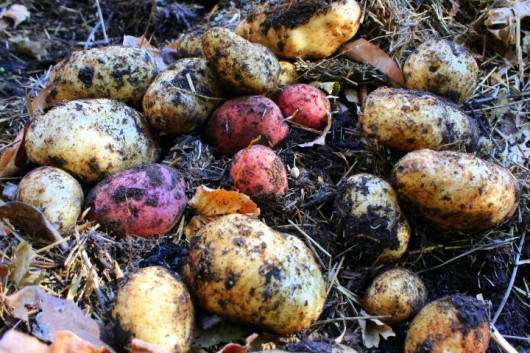 As an extra bonus, insect damage was non-existent. Why, I’m not sure. Perhaps the garter snakes (these are abundant on my property) burrowed their way into the straw, and ate all of the pests. Now, at harvest time, the snakes are hibernating. So there were no creepy-crawly surprises when I removed the straw and uncovered my loot.
As an extra bonus, insect damage was non-existent. Why, I’m not sure. Perhaps the garter snakes (these are abundant on my property) burrowed their way into the straw, and ate all of the pests. Now, at harvest time, the snakes are hibernating. So there were no creepy-crawly surprises when I removed the straw and uncovered my loot.
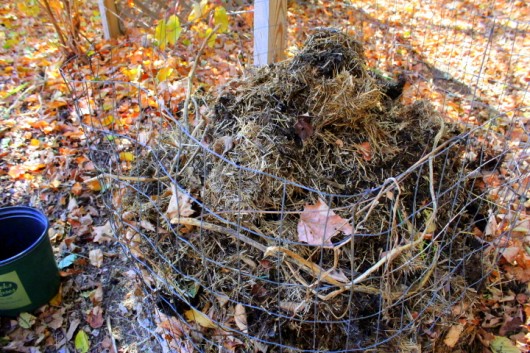 And what became of all the straw I removed? Well, I have a wire-mesh compost bin directly behind the potato bed. So in went the straw, which, unless it entirely decomposes over winter, will be perfectly useable for next year’s crop.
And what became of all the straw I removed? Well, I have a wire-mesh compost bin directly behind the potato bed. So in went the straw, which, unless it entirely decomposes over winter, will be perfectly useable for next year’s crop.
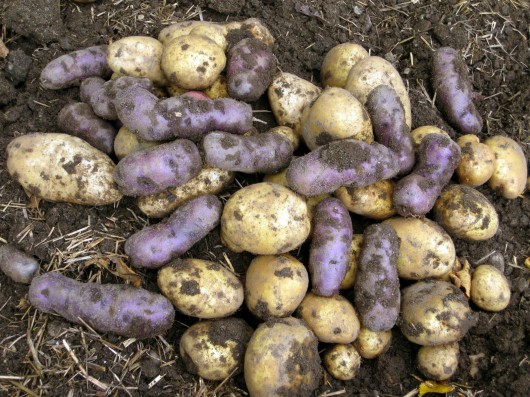 In summary, I’ll just say that if you want a really big potato harvest, you should probably plant your tubers in soil, and then hill them with additional soil. Otherwise, if you are willing to have a slightly-smaller but still-respectable crop, then simply lay your seed-potatoes on a bed of loose soil, and then mulch them, over the growing-season, with plentiful straw. This last method will definitely conserves water, and the potatoes which develop will be a breeze to harvest.
In summary, I’ll just say that if you want a really big potato harvest, you should probably plant your tubers in soil, and then hill them with additional soil. Otherwise, if you are willing to have a slightly-smaller but still-respectable crop, then simply lay your seed-potatoes on a bed of loose soil, and then mulch them, over the growing-season, with plentiful straw. This last method will definitely conserves water, and the potatoes which develop will be a breeze to harvest.
If this post was the least bit helpful to you, by all means let me know. As always, I cherish your thoughts.
Don’t miss anything at a Garden for the House…sign up for Kevin’s weekly newsletter.
Related Posts:
My Easy Kitchen Garden
How to Plant, Grow, Harvest and Store Potatoes
Recipe: Potato Croquettes
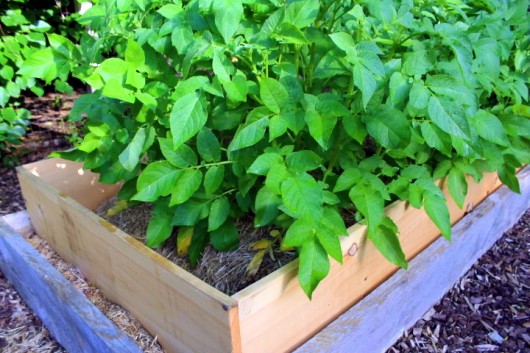

KimH says
About 28 years ago, I did the same thing after reading about doing this in Mother Earth Magazine.. I was surrounded by old fashioned country gentlemen gardeners and they told me that I was crazy & I was wasting my time & my potato seed.. I was never so happy to show them my potatoes.. and I could lift up some hay/grass to pull out some new potatoes & let the rest of them continue to mature.. Great trick & great fun! 🙂
Donna Clary says
I have also grown things in bales of straw. Love the idea with the potatoes. Will have to try this spring! Good job.
Christina liebler says
Fabulous idea ! What do you think about mulching my entire garden with straw? Sounds like a great way to minimize weeds and watering. I am sort of (completely) a plant it and let nature take its course kind of gardener, so I can use all the help I can get to minimize the work a garden might expect from me.
Kevin Lee Jacobs says
Hi Christina – Straw is great, but only when it is weed-free. For general garden use, I’d mulch first with newspaper or cardboard as described here, and then top the paper with shredded leaves or shredded bark. Speaking from experience, not a single weed will emerge from a newspaper-mulched bed!
Denise in NJ says
Christina, I mulched my raised beds this year with straw. The tomatoes did better than they have in years. The green beans did well, too. The peppers, worse. They were few and small. The sweet potatoes did, well, actually, they didn’t. Not a one.
Terry says
I have used straw in my garden as mulch the last few years. It is a great help in keeping the soil moist and sort of weed-free – it still gets some weeds (especially bindweed which just grows on top of the straw) but they are easier to pull out. I did this potato growing method this year with only some success. But I think that was mostly because I did not plant very many seed potatoes to start with.
Deb says
Yea! My Great Granparents grew potatoes this way .
Diane from Boston says
Salt marsh hay should be weed-free, if you want to try that.
Nikki Wyscaver says
I’ve heard of this method of growing potatoes and I think your experiment was terrific. I’m glad you posted about your experience!!
Meg Bagdonas says
Hi Kevin, what about mice?? I tried hilling my potatoes with straw a couple years ago and the whole bed became home to dozens of field mice. They nibbled away most of my crop. Ugh! I’m afraid to try that trick again.
Kevin Lee Jacobs says
Hi Meg Badgonas – Surprisingly, I had no issue with any pests, including mice. Maybe the bed-on-bed trick was a deterrent for them.
Terri says
My grandparents always grew their potatoes in soil. My grandfather could dig them with a pitchfork and never hit a one–must be an old timer talent!
I know a few people who have used straw for small backyard gardens and are quite happy with their potato crops.
Martha says
This is so inspiring! Thanks, as always, for the step-by-step description and pictures. And I love it that you encourage, or at least allow to prosper, your garter snakes. They are as helpful as companion plants in taking care of your garden and eliminating pests. That may explain the absence of mice, too.
Kate says
This year I planted potatoes in soil and then “hilled” with straw as well and had great results. Most potatoes were just at the soil surface and easy to harvest. I also used straw mulch instead of soil to blanch my leeks and celery. Also good results. Since my garden is long narrow rows tilled in a field with a grass/clover mix for the walk rows, there isn’t extra soil for hilling without carting it from somewhere else. I will definitely continue with this method.
Jane says
Cats. I don’t know whether Kevin has cats, or his neighbors do, but cats will solve the mice in the potatoes problem. When I first moved to where I am now in the country and could let my cats outside, my first potato crop was badly chewed on by mice even through the soil because I didn’t hill them quite enough. A year later, after my two cats had had full reign over the area for 12 months and had laid waste to the abundant local population of mice,voles and shrews, I had no signs of chomping on the spuds and haven’t had a problem with it since, even the few that heave themselves up enough to poke out of the soil.
I do plant my potatoes in the soil, but have alternated between hilling with straw and hilling with soil and can’t make up my mind which is more of a pain in the neck.
Also FYI, I don’t know where Kevin gets weed-free straw — it sure isn’t available where I am in rural Vermont — but I’ve found that a thick layer of either straw or even hay loaded with weed seeds suppresses weeds very nicely. Very few of the seeds in the hay or straw manage to make it down into the soil, and since the sun doesn’t reach them, they don’t germinate much anyway. I get a few weeds that manage, but not much, and they’re easily pulled.
Sonnie Croft says
This sounds like a very worthwhile project. I happen to have access to huge amounts of straw, and this seems like just the ticket. Can’t wait to try it next year.. I wonder what other crops would lend themselves.to heaps to heaps of straw?
Karen Hermansen says
You probably could use chopped straw with this method also. Place an old tire on the ground,put the potatoes on the soil, and cover with soil. When it grows above the tire, place another tire on top of the first one, and cover with straw. Continue using tires and straw until you feel the plants have reached their top growth. At harvest time, just lift the tires off and harvest. You could also do this with soil. This way you also do not have to dig, risking damaging the potatoes.
Donna S says
Wow! I like the results and easiness of your method. I am going to try it this next season. I have tried several methods and this it worth a try. Thank you!!
Arden Rembert Brink says
I have SO been wanting to try potatoes and am really glad to hear of your success with this. Definitely will try next year. Thanks, as always, for sharing your experiences!
Carol H. says
I want to live in a tiny cottage on the corner of your property and bask in the warmth of your lovely home.
Jo says
Kevin, I look forward to your posts every Sunday morning. I’ve wondered about growing potatoes in straw since I only have a small area to garden. I’m going to give it a try after seeing your experiment. Thank you so much!
della says
Look forward to each of ur post’s. Am going to try this next spring. Always looking for easy ways of gardening. Can’t get down on my knees anymore so any way i can do something new I’m up to trying it. Thank U
Mary Lou says
great idea—was just wondering–did you just use the whole potato or can you cut it up with the eyes showing like you would do if you pl;anted it in the ground–thaks
Diane says
Nice post, thanks! I’ve been meaning to try this, too, so happy to read your results.
I wonder what would happen if you alternated straw layers with soil layers. I may try that next year and see what happens.
Mike L. says
I also tried a similar approach to planting potatoes and came out with very happy results! Large potatoes (and a lot of them)–the only thing I did find is that the little critters did some munching on about 5% of the spuds. Now, I did not do raised beds, but planted the seeds in a hill, covered them, and then started to pile up the straw as the plants grew—it worked great, and as you have brought up in your article the potatoes are right on top of the ground under the straw! One exception: the Pontiac Reds were also going down into the soft soil, so double check and don’t miss out on extra potatoes!
Don Mulcare says
Whenever we reach the bottom of a bag of potatoes, regardless of the time of the year, I put the eye heavy spuds in the ground. If they don’t make it, there’s just that much organic material added to the bed. Fortunately, many “seed potatoes” survive.
I’m reorganizing my raised beds at the moment and plan to use a variation on your mulch method. For the time being, I’ll plant the seeds tubers deep enough to avoid the frost and add leaves and grass for insulation. When the spring arrives, and the plants reach through the mulch, I plan to use grass cuttings. These usually dry out quickly if not too heavily applied.
I’d appreciate your comments.
Thanks for sharing your creative successes.
Don
Diane (from Indiana) says
I was trying to enlarge my garden back in 1981. I laid the seed potatoes on top of the grass,
in the area I wanted as more garden. Covered it with piles of weed-free straw, and let nature take it’s course. I had tall sturdy green plants growing through the straw, and at the end of the summer when I removed the straw, I had a good crop of potatoes just laying on the ground waiting for me to pick them up. My neighbors were amazed! I was just delighted!! It was a trick I had picked up from reading Rodale’s Organic Gardening magazine.
Linda says
I had success using the black cloth Smart Pots — I used four large pots, 25 gallon I think. At planting I rolled the edges down to make the pot shorter, and could unroll it a bit each time I needed to add soil. At harvest time I dumped the entire contents of the pot into my wheelbarrow and — voila! — there were the lovely potatoes. No digging.
Hoosier John says
I’ve used this method for years, with excellent results. Even with four years in a row of summer droughts here in the Midwest, the ground under the straw has remained cool and moist with only tri-weekly watering. An added benefit is that any missed potatoes will sprout in the spring, being protected under the foot of straw, unless it’s an unusually harsh winter. By the way, for some reason, potato bugs will not bother potato plants grown in straw. I’ve read that they like to hide in the soil at night, and with their way blocked by the thick straw, they leave the plants alone. I’ve never seen a potato bug on my potatoes grown in straw, although I used to get them every year when I grew them in soil many years ago. (One can also used chopped leaves from the previous fall. I collect bags and bags of them from the neighbors’ curbs and chop them up with my lawnmower. Saves buying a lot of straw bales, although I use both leaves and straw.)
Beverly, zone 6, eastern PA says
The famous Ruth Stout would be very proud of you, Kevin!! Do you do all your chores before 11:00am too, as she did ?
Gardeners growing a lot of ornamental grasses can make their own straw, as I do. When tall decorative grasses are cut back in February, they are chain-sawed off after being tied up with a bungee cord. Then the long fronds are fed into a chipper-shredder, the kind that eats most yard waste. We have two Craftsman chippers. We did not like the Mighty Mac as it did not “eat anything and everything” like the Craftsman, but I digress. The chipped straw that comes out of the chute into the bag is a wonderful soft, attractive product to use as mulch on vegetable beds. At the end of the growing season, today in fact, the straw mulch is placed into compost bins as carbon plus “inoculant” (colonies of soil microbes) and decomposes with everything else. I love making compost. I love recycling the grasses, not once but twice. First as straw mulch and secondly as layers in the bins. When I see folks taking their long grass fronds to the township yard waste center, I am tempted to grab them up. My husband reins me in.
c. j. lengel says
Another way to raise potatoes that last throughout the season, is to plant them shallow beds
and when they bear fruit – water the garden, reach under the plants and grab your potatoes.
commonly called “grapple” the potatoes, leaving the stalks standing, and they will produce
all season, or until the very hot days. Shall try the straw garden also this year.
Karen says
I tried growing potatoes in a container last spring and had such a discouraging crop. I followed directions I saw online but mine was a real bummer. Begining to think I have a black thumb. Not even papyrus will root and live for me in water.
Laura Graham says
You make it look easy enough for me to tackle. I have never grown potatoes but would like to. We have plenty of grass. I like the idea of just putting the seeds on the grass and piling on the chopped straw and dried grass clippings. I will build a simple raised bed and when the ‘taters are done, waalah…I will have a new bed with no grass to worry about. Then the next year, another potato patch turned into a new garden bed! I wonder if you can grow sweet potatoes this way?
Dori says
I’m a specialist in this. I have been doing it for 45 years. At first the straw created a nursery for slugs (Pacific northwest mascot) but after a few years the slug predators, small black spiders, built up and took care of that problem as well as the aphids. Also home to black beetles that kill slugs and aphids. I do not destroy the straw–I let it be to protect the insect predators. I use it on asparagus to prevent asparagus bugs and weeds. I straw-mulch garlic and artichokes in winter to protect from freezing, but remove in spring to prevent onion fungus and rotting of artichokes. On and on. Straw is good. I do have a couple of cats, but no mice or shrews or rats. The cats don’t kill them; they just scare them away.
Dori says
OOh I forgot– the straw eventually decomposes in the garden and adds organic material to enrich the soil. But you already know that.
Michele Layne says
Hey Kevin nice article. When would you plant potatoes?
Julie says
This is the only way I have ever grown potatoes and I have always been very happy with the results.
I have one issue which occurred this year for the first time and that is my raised bed with the potatoes in it was overrun with ants. It was so bad that they were eating some of my potatoes and I didn’t know it. I would say I lost 1/3 of the crop.
Does anyone know how I can get rid of these ants over the winter so they don’t ruin whatever I put in that bed next year?
Monica Gray says
I grow my potatoes in pots and start them in my greenhouse earlier than i would if I was planting in the ground. I have had excellent results! I just dump them out in any new bed I am starting, which gives me a start on the new bed, too. I love to grow potatoes this way!
Karen says
Thanks for this timely hint, Kevin. My husband just dug the remainder of our potatoes last week and said he didn’t think we should plant any next year because it was too much work digging them out. It is always so nice having our own organic potatoes. They taste soooo! good!. This would make it very easy to have my potatoes and eat them too!!!
Christine says
My husband grows potatoes under black plastic. He gets this in farmer’s supply stores –we live in Ireland so I’m not sure where you would get this. He says that the recommended correct way for this method is to put the seed potatoes on the suface of the soil and cover with the plastic. When the potatoes start to shoot up, a ‘bump’ will appear in the plastic. Then cut a small x in the plastic to allow the shoots to grow through. However, he found this difficult to do without damaging the new shoots. Now , he puts the potatoes into the soil only about 2 inches down at carefully measured distances appart. Because the measurements are accurate, he is able to cut the hole in the plastic at the same time as he plants the potatoes. He can then harvest by scrabbling up the crop wth his hands or just use a small trowel. The plastic can be folded away in the Summer and used many times.
Karen Hermansen says
Julie,
Try diatomaceous earth or make a syrup of borax sugar and water. The ants will take the sugary mix back to the nest and once it poisons the queen, they will leave. The diatomaceous earth is like a dust, but is is make of of tiny one- celled sea creatures(forgot the name). It will a race their outer shells and they will dehydrate and die.
Nancy says
I always thought that it was unwise to use the same growing medium for potatoes from one year to the next because of the possible spread of any (undetected) disease. We grow our potatoes in large pots in soil and have always used fresh soil each year, using the old for flowers or veggies that aren’t related to potatoes, just as if we were rotating crops. That’s why we also buy new seed potatoes each year rather than some from our own crop. If we can use the same soil/hay, that would certainly be easier. Can you please comment on this?
Kevin Lee Jacobs says
Hi Nancy – For your potted arrangement, you are right to use fresh soil/mulch and certified disease-free “seed” potatoes each year. Here at A Garden for the House, I rotate my potato crop annually, so have no worries about disease. And as for the straw mulch…it is mostly composted already. So I’ll start with fresh straw next year.
Shawna says
Hi Kevin, just picked up Yukon Gold to plant today. I have had no luck over the past 3 years with growing potatoes. The Salbugs aka rolly- pollies, come out and devour my seedlings. So this year I’m trying to outsmart them by placing my potato starters inside these large rattan baskets with soil on the bottom and covering with straw when they sprout. I will keep adding on additional rattan baskets to grow vertically. I’m thinking I’ll also try the wire fence cage approach too. You have given me some hope to try again.
Question: I’m in So CA- Orange County area. No Fall here, in fact it will be 80 all week. I grow lots of things in my raised beds, but am afraid I’m depleting my soil. What do you think about planting cover crops like oats and peas to refresh the soil as well as chopped up leaves?
Kevin Lee Jacobs says
Hi Shawna – I’ve never grown cover-crops in my raised beds, and even after 8 years of planting, my soil is terrific. The secret? I mulch the beds year round, usually with shredded leaves, and sometimes with chopped straw. These materials break down and become nutrient-rich compost. Good luck with your potato crop — Yukon Gold is my favorite.
George & Laura says
Sounds like a great idea and easy too. We have been really enjoying your newsletters. Thanks for all the laughs.
Randi says
How would this work with shredded leaves? Where does one get straw that has not been grown with chemicals? I appriceiate all this great info!
Larry says
I mulch EVERYTHING with either spoiled hay or baled weeds. I got 4 bales of weeds from a fella in upstate N.Y. and have been using it as mulch on cardboard. No weeds and it turns into a GREAT fertilizer, just like compost! Ruth Stout promoted this method back in the ’50’s. Worked then and will now, too.
Alice says
I have a number of small sweet potatoes left from this year’s harvest; can I use these small ones to plant the next crop?? or will these small potatoes yield small crop?? i.e., inferior potatoes lead to inferior crop?
Jan says
This sounds like a great method. I have grown potatoes in the past, but had stopped because they are a pain to harvest. I will definitely give this a try. I think it will keep the potatoes cooler, as well, and I like the fact that it keeps watering way down. I am in the Bay Area of California, and we are in a killer drought.
Kat Sander says
I’m anxious to try planting potatoes and am going to use the straw method. I live in Ft Lauderdale. Any growing tips for our hot, rainy, and high humidity climate?
Heather Smith says
On a whim we planted sweet potatoes in grass clippings behind our shed. We have such a nice crop (at least the leaves look very nice) that I have to start reading up on harvesting curing etc. I did not know anyone had attempted grass clipping potatoes lol….will let you know the quality and quantity of our crop in about a month.
Lisa says
I tried this for the first time this year. A wire “cage” frame, lined with cardboard at the soil level, then mulching with straw. I pushed it over just a few days ago, and got a total of four tiny taters! Four, and a few half pencil eraser sized ones. Not worth my effort. They were German Butterballs.
Dorothy says
My dad planted potatoes in straw and I have done the same for past 50 years. I have the same patch, 10 x 10 that produces generally 400#. I don’t count,my starts, just tuck them in about every foot every which way, not in rows. I start with old hay then toss on any weeds as the summer goes on. I do get some weeds in the patch which are difficult to reach thru the heavy planting, but they do not root deep, generally are something beneficial insects like, so I just leave them until I harvest spuds. The dirt in this garden is a good foot deep of rich topsoil. I have had no disease issue s, save and replant all the little guys come spring. Occasionally little critters snack on them underground but I figure there are plenty to go around. I store the perfect ones and we have lots of potato yummy dinners from the critter trimmed spuds.
I did sweet potatoes the same but on a little hill of old manure and hay mixed, covered in pulled weeds, all just starting to rot nicely. Tucked in the slips and had huge sweet potatoes. A number were 5#. One was a full 9# on scale and beautiful to eat. Yes, I took a picture but years ago with a real camera. I thought maybe the heat of the composting pile helped them grow better. Most years had just the normal size.
Nancy Rosenthal says
We’d have to haul dirt to cover the plants so this is a great solution. Will get on it today and the plants have broken thru the first burial. Thanks.
Sue says
Hi Kevin, well here it is ten years after you first write this and I’m finding it so helpful. Apart from your usually wonderful , generous, well honored, delightful and practical suggestions, what is really nice to see us that your effort also gets other people either getting enthused or sharing some great ideas and wisdom. I live the people in these comments who said they have been growing potatoes , in some sort of related “straw ” way for 45 or 50 years !!! Without you writing and sharing all these comments would not happen. Actually it’s like your articles and sharing make a little garden patch of comments , each different but generally chirpy, from new gardeners to very experienced , all singing their tube like a flock of happy chirpy birds ! Thanks for alllll you do!!
Sue
Michael Turner says
Well it depends on where you live because normally the straw method attracts more bugs. Plus most straw has come from farms using herbicides and pesticides and can wipe out the beneficial insects , and even the worms in your soil.